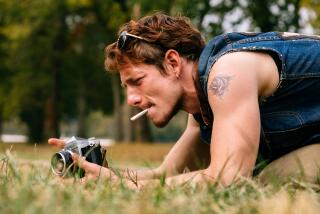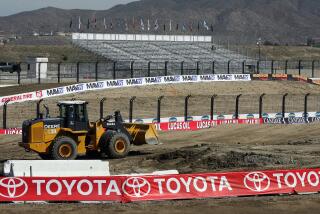A Deadly Side to the Baby Boomers’ Thrill Ride
- Share via
WASHINGTON — A young Che Guevara set off on a motorcycle through the Andes, seeking the soul of Latin America. “The Wild One” and “Easy Rider” evoked for Americans the bike’s raw power and unfettered spirit.
But the passion of rebels, outlaws and daredevils is fast becoming the pastime of aging baby boomers. And as 40- and 50-somethings mount gleaming new bikes to recapture their youth, one result has been an alarming increase in casualties.
After declining through most of the 1990s, motorcycle fatalities began trending upward in 1998, and older bikers are behind the increase, a Los Angeles Times analysis of federal statistics shows.
From 1994 to 1999, deaths among bikers age 35 and older rose by 59%. During the same period, fatalities fell by 22% among those 34 and younger. For the first time, in 1999, older riders accounted for a majority of those killed. That was also the year the trailing edge of the baby boom generation turned 35.
“These trends fly in the face of the conventional wisdom about who’s getting killed on motorcycles,” said Rae Tyson, a spokesman for the National Highway Traffic Safety Administration, whose research reflects a similar pattern. “They certainly suggest we need to focus on training for those who are returning to motorcycling after a long absence or getting into it for the first time at an older age.”
What is it about motorcycling that has gotten in the blood of middle-age Americans?
“There is a certain mystique about the American-made Harley-Davidson,” said Pat Delahunty, 50, an electronics technician during the week and on weekends road captain of the Inland Empire HOG (Harley Owners Group). “People just love it. Tourists from Japan stop to take pictures. The feeling, the sound of the bike when it goes down the road. . . . It’s awesome. It’s 100% addictive.”
Largely because motorcycling gets little scrutiny by safety researchers, the reasons for the generational shift in casualties are unclear. Inexperience, overconfidence and alcohol consumption play a part. Overexposure to traffic hazards among older riders who favor full-day treks of hundreds of miles also may be a factor. Or it could be demographics, pure and simple--the sheer number of baby boomers saddling up for the first time or returning to the sport after a long absence. That has prompted a rapid “aging” of the motorcycle population.
“Many of the questions that people are asking . . . no one knows the answer to them,” said David Thom of the Head Protection Research Laboratory in Paramount. “There has been no in-depth investigation of motorcycle safety in this country for 20 years.”
Older Doesn’t Mean Wiser
Motorcyclists accounted for 2,472 of the 41,611 people killed on America’s roads in 1999--about 6% of the total. During the last decade, the average age of bikers killed rose from 29.3 in 1990 to 36.5 in 1999, according to NHTSA statistics.
Contrary to expectations, the agency found that older, and presumably wiser, people may in fact be taking more risks. While the motorcycle accident death rate for people 29 and younger dropped sharply since 1990, it increased for those 40 and older. Overall, those in the 20-29 age group still were the most likely to be killed on a bike, but by 1999, their risk of dying was 42% lower than at the start of the decade.
Meanwhile, the death rate for those 49 and older had surpassed that of people younger than 20. NHTSA is working on a new motorcycle safety plan, taking into account the graying biker.
Aging riders were out in force recently at Bike Week, an annual happening that draws hundreds of thousands to Daytona Beach, Fla. At the first-aid tent, hypertensives outnumbered Hells Angels. “Quite a few had elevated blood pressure and probably about half of those having it checked were on medication,” said Debbie King, trauma program coordinator at Halifax Medical Center in Daytona Beach. More than 1,000 riders had their blood pressure checked.
“We saw a couple of gentlemen whose bikes just fell over on them. Both were over 60 and one was near 70,” King added. “One had a possible broken rib--we sent him by ambulance to the hospital for an X-ray.”
Dropping a 600-pound Harley while you’re parked at the sidewalk probably hurts the ego more than anything else. Being flung from a bike at highway speed is another matter.
Earl Kline, a 48-year-old computer programmer from San Diego, blames inexperience for his crash in 1996 near Las Vegas. He had been riding for about a year.
Racing in a pack at about 90 mph down a highway, Kline bumped the bike in front. He left the road, hit a ditch, became airborne and landed 15 to 20 feet away, breaking most of his ribs, a leg and a hand. He was wearing a helmet. His Honda sports touring bike was totaled. Kline was hospitalized for 10 days; he was out of work for a month. He has not bought another bike since, though he’s thinking about it.
“It was just a lot of fun until the very last second,” Kline said. “I wasn’t worried about getting killed. . . . I figured I would get hurt.”
Market Trending Toward Upscale
Last year, the typical buyer of a new motorcycle was a 42-year-old male with a median income of $67,000, according to the marketing research firm J.D. Power and Associates. Bikes can range from less than $5,000 to as much as $30,000. The main types are cruisers, epitomized by the classic Harley; sport bikes, the ninja-style machines that race the Angeles Crest Highway; and touring bikes, solid, long-haul transportation with windshield, luggage compartment and other amenities.
Middle-age converts to motorcycling sometimes are called “born agains” or “rubies”: rich urban bikers.
“These newer, older riders are not starting out small,” said Eric Levy, 40, membership coordinator of the Red Hot Riders Motorcycle Club in San Diego. “They are buying big bikes, which are a handful. The [attitude] is, ‘Heck, I can do this, I’ve been around for a while--and out of my way.’ ”
While many states, including California, require younger riders to take a motorcycle safety course before getting a license, older adults often can go straight to the Department of Motor Vehicles examiner. Training courses, though recommended even for experienced riders, are overbooked. Facing a months-long wait, some learn enough on their own to pass the test or they start riding without a motorcycle license. Bikers involved in fatal crashes are more likely to be unlicensed than other motorists in fatal crashes.
But skill is essential for self-preservation on a motorcycle. Braking--especially in panic situations--is tricky because the front and rear brakes are operated independently. The front brake usually is applied by squeezing a lever on the right handlebar and the rear brake operates by a foot pedal. The sport also requires constantly active thinking. Unlike the driver of a sport-utility vehicle, a motorcyclist must assume that he or she is invisible to other drivers and learn to anticipate their actions.
“It is erroneous to equate age with experience,” said Bob Young, a motorcycle safety instructor for seven years in the Maryland suburbs of Washington. “Maybe we should assume that the older the rider, the less experience.”
Statistics indicate that older bikers also are more likely to drink alcohol before riding. The highest intoxication rate among fatally injured motorcyclists in 1999 was in the 35-39 age group--45%. That was followed by the 40-44 age group at 39%. The drunken driving rate for motorcyclists of all ages is much higher than for drivers of cars and light trucks. And bikers who have been drinking also are less likely to wear helmets.
“Once in a while, you see them have a couple too many beers, get in a fight with their girlfriend, jump on the bike and take off into the desert,” said Delahunty, the Harley road captain.
Jane Usatin, treasurer of the Southern California Motorcycling Assn., believes riding patterns are another factor that works against older motorcyclists.
“The younger riders ride for an afternoon, or early in the morning, before the cops are out,” she said. But older bikers favor social rides that can reach hundreds of miles in a day. “They hit the road in the morning and are out there until dusk. By then, they have been exposed to the dangers of the road for longer. I ride 3,500 miles a month, easy. I’m just out there being a target.”
A college administrator, Usatin, 52, said she wouldn’t give up the lifestyle. She’s a grandmother, and one of her daughters was riding a motorcycle before she learned to drive a car. Usatin met her second husband at a motorcycling event. “He thought I was a guy. Boy, did it surprise him when I flipped up the helmet.”
Usatin knows of four riders who were killed in recent years. One was a young man who took a turn too fast. The other three were older. One came over a rise to find a truck unexpectedly blocking the road and was unable to stop. Another was riding through the Navajo nation at night in rainy weather when he was blinded by the high beams of an oncoming car, went off the road and flipped. The third one was hit by flying debris on a Los Angeles freeway.
As people remain active later in life, the number of older--even elderly--bikers can be expected to climb higher. Dean French of San Diego runs a business at age 73 and still rides a Honda sport bike in the mountains. He has noticed that his reaction time has slowed and he gets tired more easily, but he ignores his wife’s pleas to give up biking after 40 years.
“The motorcycles of today are far more capable,” he said. “You have the ability to go fast and make rapid turns and lean over--all the things the racers did 10 years ago. The technology may seduce you into thinking you are more capable than you are.”
French taught one of his best friends to ride when the friend was 63.
Over the years, French has had several serious accidents. He got in a life-threatening wreck about 20 years ago, racing around a practice track near Chicago.
“It cost $20,000 and my spleen had to be removed,” he said. “I promised my wife I would never get on a bike again. But then I did as soon as I got out of the hospital.”
(BEGIN TEXT OF INFOBOX / INFOGRAPHIC)
Motorcycle Fatalities by Age
Aging Motorcyclists
Average age of owners:
1980: 26.9
1998: 38.1
Sources: National Highway Traffic Safety Administration, Fatality Analysis Reporting System;2000 Motorcycle Industry Council Statistics; compiled by SUNNY KAPLAN/Los Angeles Times
*
Times researcher Sunny Kaplan contributed to this story.






